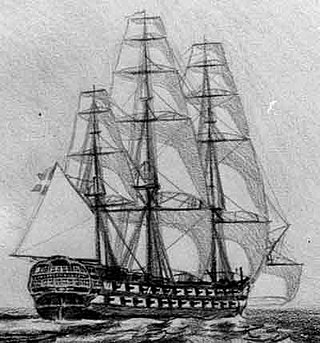Related Research Articles

Denmark and the former real union of Denmark–Norway had a colonial empire from the 17th through the 20th centuries, large portions of which were found in the Americas. Denmark and Norway in one form or another also maintained land claims in Greenland since the 13th century, the former up through the twenty-first century.

The Royal Danish Navy is the sea-based branch of the Danish Armed Forces force. The RDN is mainly responsible for maritime defence and maintaining the sovereignty of Danish territorial waters. Other tasks include surveillance, search and rescue, icebreaking, oil spill recovery and prevention as well as contributions to international tasks and forces.

The Gunboat War was a naval conflict between Denmark–Norway and Great Britain during the Napoleonic Wars. The war's name is derived from the Danish tactic of employing small gunboats against the materially superior Royal Navy. In Scandinavia it is seen as the later stage of the English Wars, whose commencement is accounted as the First Battle of Copenhagen in 1801.

HDMS Najaden was a frigate in the Royal Danish-Norwegian Navy. She was commissioned in 1811 and originally carried 36 guns, later being upgraded to 42. She served briefly during the Gunboat War only seeing action once, when on 6 July 1812 the British ship of the line HMS Dictator and the Cruizer-class brig-sloop HMS Calypso sank her during the Battle of Lyngør. The Battle of Lyngør effectively ended Denmark's involvement in the Napoleonic Wars.

The Battle of Lyngør was a naval action fought between Denmark-Norway and the United Kingdom in 1812 on the southern coast of Norway. The battle ended in a Dano-Norwegian defeat, and marked the end of the Kingdom of Denmark-Norway's involvement in the Napoleonic Wars.

Holsteen was a 60-gun ship of the line in the Royal Dano-Norwegian Navy. She was commissioned in 1775 and the British Royal Navy captured her in the Battle at Copenhagen Roads on 2 April 1801. The British renamed the ship HMS Holstein, and later HMS Nassau. She participated in one major battle during the Gunboat War and was sold in 1814.

The history of the Danish navy began with the founding of a joint Dano-Norwegian navy on 10 August 1510, when King John appointed his vassal Henrik Krummedige to become "chief captain and head of all our captains, men and servants whom we now have appointed and ordered to be at sea".
Trost may refer to:
John Cunningham was a Scottish nobleman, explorer, Dano-Norwegian naval captain, and Governor of Finnmark.
Godske Christoffersen Lindenov or Lindenow was a Danish naval officer and Arctic explorer. He was a commander on one of King Christian IV's expeditions to Greenland.
Carsten Richardson was an early 17th-century Holsteinian-Danish naval officer and Arctic explorer. He was the commander of King Christian IV's final expedition to Greenland.

Christian IV's expeditions were sent by King Christian IV of Denmark-Norway to Greenland and Arctic waterways during the years 1605–1607. The expeditions were commissioned in order to locate the lost Eastern Norse Settlement and reassert sovereignty over Greenland.

The Dannebroge was a Dano-Norwegian ship-of-the-line that exploded and sank on 4 October 1710, during the Great Northern War. Almost all of its crew of 600 were killed - one third of the victims were Norwegians. Admiral Iver Huitfeldt was among the casualties.
HDMS Lolland was launched in March 1810. She served in at least four major engagements during the Gunboat War before she was transferred to the Norwegian navy after the Treaty of Kiel brought about the separation of Norway from Denmark in 1814. Lolland continued to serve with the Norwegian Navy until sold in 1847.

The Norwegian gun-ships were a class of ten armed schooners that served first in the Royal Dano-Norwegian Navy, and then after 1814 in the Royal Norwegian Navy. The first was launched in 1808 and the last was lost in 1872.
Den Røde Løve was a 70-ton ship of the Dano-Norwegian navy. It served during the early 17th century, when it was recorded as carrying 6 guns.
Katten was a 20-ton yacht of the Dano-Norwegian navy. It was purchased from Scotland in 1605 and was probably only armed with a few guns.
Buskø was a small Norwegian sealer, seized by the U.S. Coast Guard in East Greenland in September 1941, before U.S. entry into the war. She was bringing supplies and rotating personnel for the Norwegian hunting stations there. The episode is notable not only for the uproar in the American press when Buskø was towed to Boston as a prize, but also because it is frequently but incorrectly listed as being the first American capture of an enemy surface vessel in the war. Finally, President Franklin D. Roosevelt had frequently asserted that Germany would attempt to establish a foothold in Greenland, and the way this episode was presented seemed to bear him out. The affair was a notable early initiative in the North Atlantic weather war.

The battles at Göta älv were a series of battles and sieges which took place in and around the Gothenburg area between 1717 and 1719, between the Swedish Empire and Denmark–Norway, during the Great Northern War.

HDMS Grønland (Greenland) was a ship of the line of the Dano-Norwegian Navy, built in 1756 and decommissioned in 1791. Grønland spent considerable time in the Mediterranean Sea, where she protected Danish merchant convoys. Grønland took part in the bombardment of Algiers in 1770 but otherwise did not see any action in battle. It is noted in the Danish Admiralty's papers that she was an unusually seaworthy ship.
References
- ↑ Record Card for Trost (1602)
- ↑ Record card for Trost(1625)
- 1 2 3 Gosch, C.C.A. (1897). Danish Arctic expeditions, 1605 to 1620.